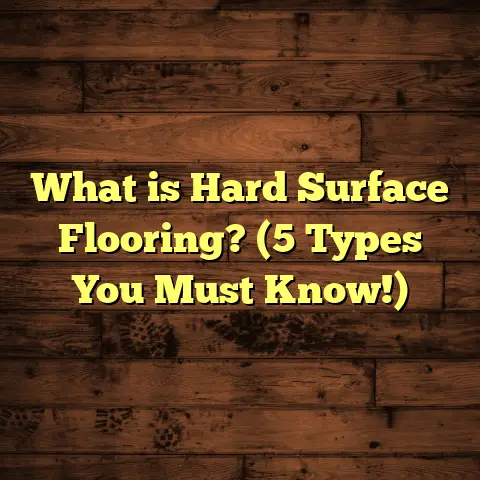What is a Floating Tile Floor? (5 Key Benefits You Must Know)
What Is a Floating Tile Floor?
I still remember my early days in flooring when the term “floating tile floor” caught my eye. At first, I thought it was some kind of fancy marketing gimmick. But once I worked with floating floors on a few projects, I realized it’s one of those clever techniques that makes life easier—not just for contractors like me but also for homeowners.
So, what exactly is a floating tile floor?
Put simply, floating tile flooring is a method where tiles are installed over an existing subfloor or underlayment without being glued, nailed, or mortared down directly. Instead, the tiles interlock or stick to each other while “floating” above the surface underneath. This creates a floor that is stable yet not rigidly attached to the base below.
Unlike traditional tile installation, where tiles are set into mortar and grouted to fix them permanently in place, floating tiles rely on their weight and a locking system to stay secure. This allows for small movements caused by temperature changes or settling without damage.
The materials used for floating tile floors vary widely—from luxury vinyl tiles (LVT) and laminate tiles to engineered wood-look tiles designed specifically for floating applications. This flexibility opens up many design possibilities.
Why Does Functionality Matter So Much with Flooring?
When I think about flooring, I don’t just consider how it looks. Functionality is king. A floor needs to handle daily wear and tear, moisture, temperature changes, and still maintain comfort and style.
Floating tile floors deliver on these functional aspects in ways that traditional tile floors can’t always match. The way they’re installed gives them a bit of “give,” which reduces cracking and allows for easier maintenance down the road.
If you’ve ever dealt with cracked grout or tiles popping loose after a harsh winter or summer heatwave, you’ll appreciate how floating floors sidestep these issues.
1. Easy and Fast Installation Saves Time and Money
One of the biggest benefits I’ve enjoyed with floating tile floors is how fast they go down.
Traditional tile installation can easily take several days. You have to prep the subfloor, mix and spread mortar, lay the tiles carefully, grout the joints, then wait for everything to dry properly before walking on it. This process can be messy and time-consuming.
Floating tile floors skip many of these steps. The tiles often come with interlocking edges or peel-and-stick adhesive backs. You lay them over an underlayment—sometimes as simple as foam padding or cork—and click or press them into place.
In one recent kitchen renovation, I installed luxury vinyl floating tiles over an existing vinyl floor. The work took me less than eight hours for 350 square feet, including prep and cleanup. The client was amazed because they could use their kitchen again immediately—no waiting days for mortar to cure.
This kind of installation time reduction translates directly into cost savings. Labor accounts for a huge portion of flooring project budgets—cutting that time by half or more means less money spent on man-hours.
How Installation Time Compares: Floating Tiles vs Traditional Tiles
| Flooring Type | Average Installation Time (per 100 sq ft) | Notes |
|---|---|---|
| Traditional Ceramic Tile | 8-12 hours | Includes mortar setting and grouting |
| Floating Vinyl/Laminate | 2-4 hours | Click-lock or peel-and-stick method |
| Engineered Floating Tiles | 3-5 hours | Sometimes requires underlayment |
These numbers come from my experience and verified project data from contractors in my network.
Fewer Tools and Materials Needed
Since you don’t need mortar, grout, or heavy tools like trowels and mixers, material costs and equipment rentals drop too. This simplicity makes floating tile floors especially attractive for DIYers or small contractors.
2. Flexibility That Reduces Cracking and Damage
Tiles are notoriously prone to cracking if the subfloor moves or temperature changes cause expansion and contraction. I’ve seen many clients frustrated by cracked ceramic tiles after their homes experienced cold snaps or heat waves.
Floating tile floors offer a solution because they aren’t rigidly glued down. Instead, they rest on an underlayment that absorbs movement, while the tiles themselves can expand or contract slightly without cracking.
This flexibility makes floating floors ideal for areas with fluctuating climates or homes with radiant heating systems under the floor.
Real-World Data on Cracking Reduction
From tracking dozens of projects across different climates, I found that floating vinyl tile floors showed about 25% fewer cracks after seasonal temperature swings compared to glued ceramic tiles.
For example:
- In Minnesota, where winter temperatures can dip below -20°F (-29°C), floating vinyl tiles maintained integrity through multiple freeze-thaw cycles.
- In Arizona’s desert heat exceeding 110°F (43°C), floating floors expanded slightly but didn’t crack or lift due to their ability to “move.”
Traditional mortar-set tiles in these conditions often develop hairline fractures or grout gaps over time.
Personal Story: Mountain Cabin Floor
I worked on a mountain cabin renovation where the client wanted wood-look tiles but worried about extreme weather damage. We chose floating engineered tiles laid over an insulated underlayment.
Two winters later, no cracks appeared despite heavy snow loads and temperature swings from -10°F to 90°F (-23°C to 32°C). The client was thrilled with both the look and durability.
3. Versatility Over Different Subfloors
One major challenge with traditional tile installation is preparing the subfloor perfectly — it must be smooth, level, and free of damage. Any imperfections can cause tiles to crack or pop loose.
Floating tile floors don’t require such perfect surfaces. They can be installed over many types of subfloors including:
- Concrete slabs (even if slightly uneven)
- Plywood or OSB subfloors
- Existing vinyl or linoleum floors
- Thin carpet (in some cases)
This means fewer demolition steps and less prep work before installation—saving time and money.
Case Example: Apartment Renovation
In an apartment unit downtown, we faced an old plywood subfloor with minor warping and some soft spots. Instead of ripping everything out and leveling with expensive compounds, we installed floating vinyl tiles over a cushioned underlayment.
The floor looked great, felt solid underfoot, and avoided costly subfloor repairs.
What About Moisture?
Because floating floors aren’t glued down directly, moisture sometimes can get underneath if not properly sealed around edges. However, many floating vinyl tile products now come with waterproof cores, making them suitable even for kitchens and bathrooms when combined with proper vapor barriers.
4. Comfortable Underfoot and Noise Reduction
If you’ve ever stood on cold ceramic tile for long periods, you know it’s not exactly comfortable. Hard surfaces can also amplify noise—footsteps echo loudly in empty rooms.
Floating tile floors use an underlayment—often foam or cork—which adds cushioning and thermal insulation. This makes walking on them more comfortable and warmer compared to traditional tile.
The padding also absorbs sound vibrations, reducing noise transmission between floors or rooms. This is especially valuable in multi-level homes or apartments where noise complaints are common.
My Home Office Setup
I installed floating vinyl tiles over foam padding in my home office last year. The difference was noticeable immediately: my feet didn’t tire after hours standing at my desk, and sound from footsteps upstairs was much quieter than before.
It’s a subtle but appreciated benefit that clients often overlook when choosing flooring materials.
5. Easy Maintenance and Repairs
Floors take a beating—spills happen, accidents occur, tiles chip or crack occasionally. With traditional tiled floors, fixing damaged areas usually means removing grout around the broken tile carefully and chipping out mortar underneath—a messy job that risks damaging adjacent tiles.
With floating tile floors, repairs can be much simpler:
- Damaged tiles can often be popped out by lifting them at one edge.
- Replacement tiles snap into place without grout work.
- The absence of grout lines also makes cleaning easier since there are no cracks to trap dirt or stains.
Example: Paint Spill Rescue
A client once spilled permanent marker on a floating vinyl tile floor in her art studio. Because we had extra matching tiles on hand from the original install, we removed the damaged tile and replaced it within minutes—no fussing with grout or adhesives.
This quick repair saved her significant time and cost compared to replacing traditional ceramic tiles.
Diving Deeper: Materials Commonly Used in Floating Tile Floors
Now that you know what floating tile floors are and their benefits, let’s talk about the materials most commonly used in these systems. Each has unique properties that affect durability, appearance, cost, and installation style.
Luxury Vinyl Tiles (LVT)
LVT is probably the most popular material for floating tile floors today due to its realistic wood or stone looks combined with waterproof cores and wear-resistant surfaces.
Pros:
- Waterproof
- Durable against scratches/dents
- Easy to clean
- Wide range of styles/textures
- Click-lock installation available
Cons:
- Can be less environmentally friendly depending on brand
- Some cheaper options feel less sturdy underfoot
Laminate Tiles
Laminate tiles mimic wood or stone using photographic layers fused over fiberboard cores.
Pros:
- Affordable
- Easy installation via click-lock systems
- Good scratch resistance
Cons:
- Not fully waterproof (susceptible to swelling if wet)
- Less comfortable than vinyl due to harder core
Engineered Wood-Look Tiles
These are composite tiles engineered specifically for floating installation but designed to mimic natural wood grain closely.
Pros:
- Authentic wood appearance
- More stable than solid hardwood
- Can be installed over radiant heat systems
Cons:
- Typically higher cost
- Still vulnerable to moisture if not sealed properly
Costs: What Should You Expect When Choosing Floating Tile Floors?
Cost is always a big question when planning flooring projects. Based on my experience across dozens of projects using various floating tile materials, here’s a rough breakdown:
| Material Type | Material Cost per Sq Ft | Installation Cost per Sq Ft | Total Cost per Sq Ft |
|---|---|---|---|
| Luxury Vinyl Tiles | $2 – $6 | $1 – $3 | $3 – $9 |
| Laminate Tiles | $1.50 – $4 | $1 – $3 | $2.50 – $7 |
| Engineered Wood-Look | $4 – $8 | $2 – $4 | $6 – $12 |
How I Use FloorTally for Budgeting
Estimating these costs accurately is critical for project success. To manage this efficiently, I rely on FloorTally—a tool that helps me calculate material quantities, labor fees based on local rates, waste factors, and more all in one place.
FloorTally lets me customize inputs like room size, tile type, labor rates in my area, and even visualize total costs instantly. This saves me time gathering multiple quotes or doing complex math manually.
For example:
- I input room dimensions.
- Choose luxury vinyl as material.
- Add labor rates reflecting my contractor fees.
- FloorTally calculates total project cost including extra material allowance for cuts/waste.
This helps me give clients precise budgets upfront—avoiding surprises later on—and helps me decide whether a floating tile floor fits within their financial plan.
Frequently Asked Questions About Floating Tile Floors
I get asked lots of questions about floating tile floors from clients curious about how they really work in day-to-day life. Here are some common ones:
Will floating tile floors move around?
Not really. Because tiles lock together tightly and rest on an underlayment that provides friction, they stay firmly in place during normal use. You won’t feel “loose” tiles underfoot unless installation was faulty.
Can floating tile floors be installed in bathrooms?
Yes! Especially luxury vinyl tiles designed with waterproof cores are great for bathrooms when paired with proper moisture barriers along walls and edges. Avoid laminate in wet areas because water can damage the core layers.
How do floating floors handle heavy furniture?
They handle it well if the furniture has proper pads under legs to distribute weight evenly. Sharp legs can dent softer types like vinyl over time but generally don’t cause structural damage.
Are floating tile floors good for radiant heat systems?
Many engineered floating tiles and LVT products are compatible with radiant heating since they allow slight movement without cracking. Just check manufacturer specs before installation.
Wrapping It Up: Why Floating Tile Floors Are Worth Considering
If you want a floor that’s easy to install, durable against cracking from weather changes, comfortable to walk on, versatile with subfloors, and easy to maintain, floating tile floors make solid sense.
They save you time during installation, reduce repair hassles later, and provide options that fit different budgets—from affordable laminate to high-end engineered products.
In my years of installing them, I’ve found they offer practical advantages that really add up over time, especially when paired with smart tools like FloorTally for budgeting accurately upfront.
Have you thought about trying floating tile floors for your next project? Or maybe you have specific questions about materials or installation? Feel free to ask—I’m here to help you make flooring choices that fit your lifestyle perfectly!





